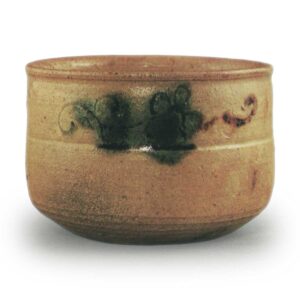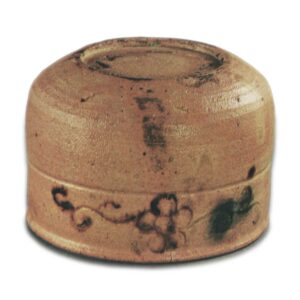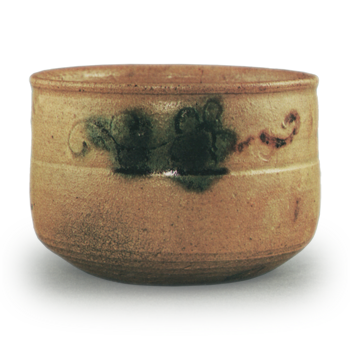

Collection: Hatakeyama Memorial Museum
Height: 7.15cm
Diameter: 10.8-10.9cm
Outer diameter of foot: 6.1-6.3cm
Height: 0.3-0.4cm
The HATAKEYAMA family’s KISE-TO tea bowl is a typical and beautiful bowl that possesses the ideal color tone of the skin of deep-fried tofu, and is one of the so-called “Ayame-te” bowls. However, it was not originally made as a tea bowl, but was originally a side dish for food, and was later taken up as a tea bowl by tea masters. There are other examples of this, such as the KISE-TO tea bowl “Namba”.
The Momoyama period was a time when new styles of pottery tableware appeared, and examples of this can be seen in the tea ceramics of Kiseido, Shino, Oribe, Karatsu and other styles. Among these tableware, there was a trend to select suitable and well-made pieces, mainly from Kiseido, as matcha bowls. It is not clear when this new trend began, but it is thought to have started around the time of Enshu. In addition to Kiseido, Karatsu, Shonzui and Kosome mukozuke were also used. The reason why Kiseido is so common is probably because there are very few examples of Kiseido tea bowls.
The most notable features of this tea bowl are the beautiful finish of the yellow stoneware glaze and the attractive, well-balanced shape. Firstly, the clay and glaze do not assert their individual characteristics separately. The pale yellow glaze blends halfway into the slightly abalone-patterned clay, creating a single, beautiful, uniform surface. The somewhat rough, yet also moist and wet, subtle sheen, and the somewhat withered coloration, all combine to create a warm, moist tone, and it is this mysterious feeling that is also interesting about the term “abura-age”. The dark brown burn marks around the bottom are also a characteristic feature of this type of deep-fried tofu skin. The origins of Kise-to glaze can be traced back to the ash glaze of the Fujiwara period, but although it was originally intended to imitate Chinese celadon, it was never successful, and by the Momoyama period it had transformed into something completely different.
The flawless wheelwork seen in this tea bowl is so precise that it could be called precise, and the well-formed shape born from this skilled technique is truly different from the distorted tea bowls of the Shino and Oribe styles that were popular at the time, but the tasteful way in which this is highlighted shows the excellent discernment of the tea masters of the time.
The elegant shape of the rim, the way the neck is formed by the band-like rim, the natural beauty of the body strap, the elegant round bulge from the waist to the base, and the fact that it is not supported by a regular foot ring, but is instead finished off with a go-sutsu base – it is a beautiful proportion, with absolutely no waste. , and the elegant round bulge from the waist to the bottom, and the fact that this is not supported by a normal foot ring, but is finished off with a go-sutsu-soko (bottom of a go-sutsu), it is a beautiful proportion with absolutely no waste.
Furthermore, the vivid arabesque pattern on the neck is truly a crowning touch. This five-petal arabesque pattern, which is often used on similar yellow Seto ware, is particularly nimble in its sword-like technique, and the deep, vivid color tone of the green spots created by the inosu is also wonderful, as is the judicious placement of the tan-colored lines created by the oniita. Furthermore, the overlapping of the line carving, the gall bladder and the demon plate, which has a different feel on each side, is a truly refined and detailed touch.
As for the accessories, there is nothing in particular to note other than the box with the Enshu-style writing on the outside.



